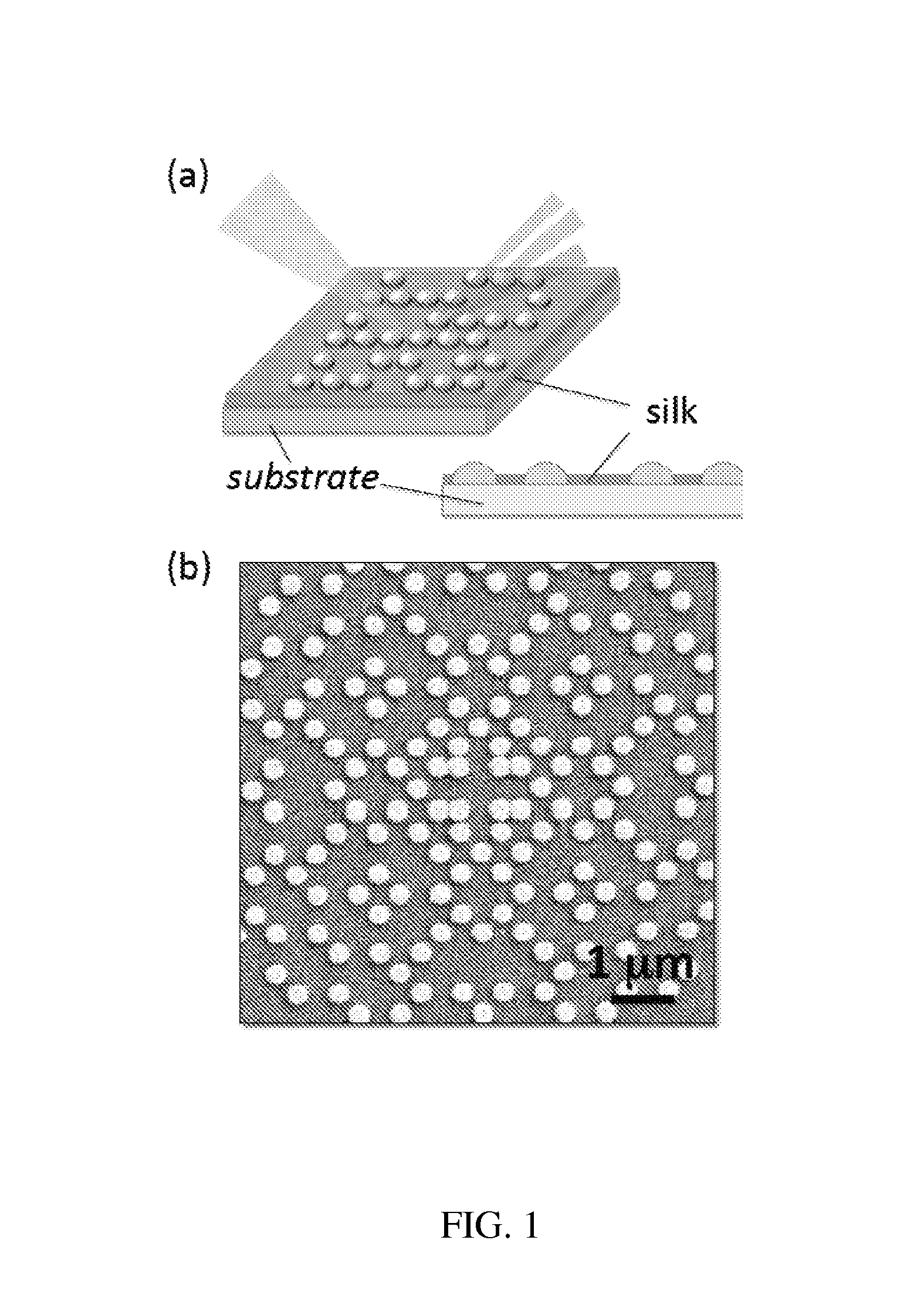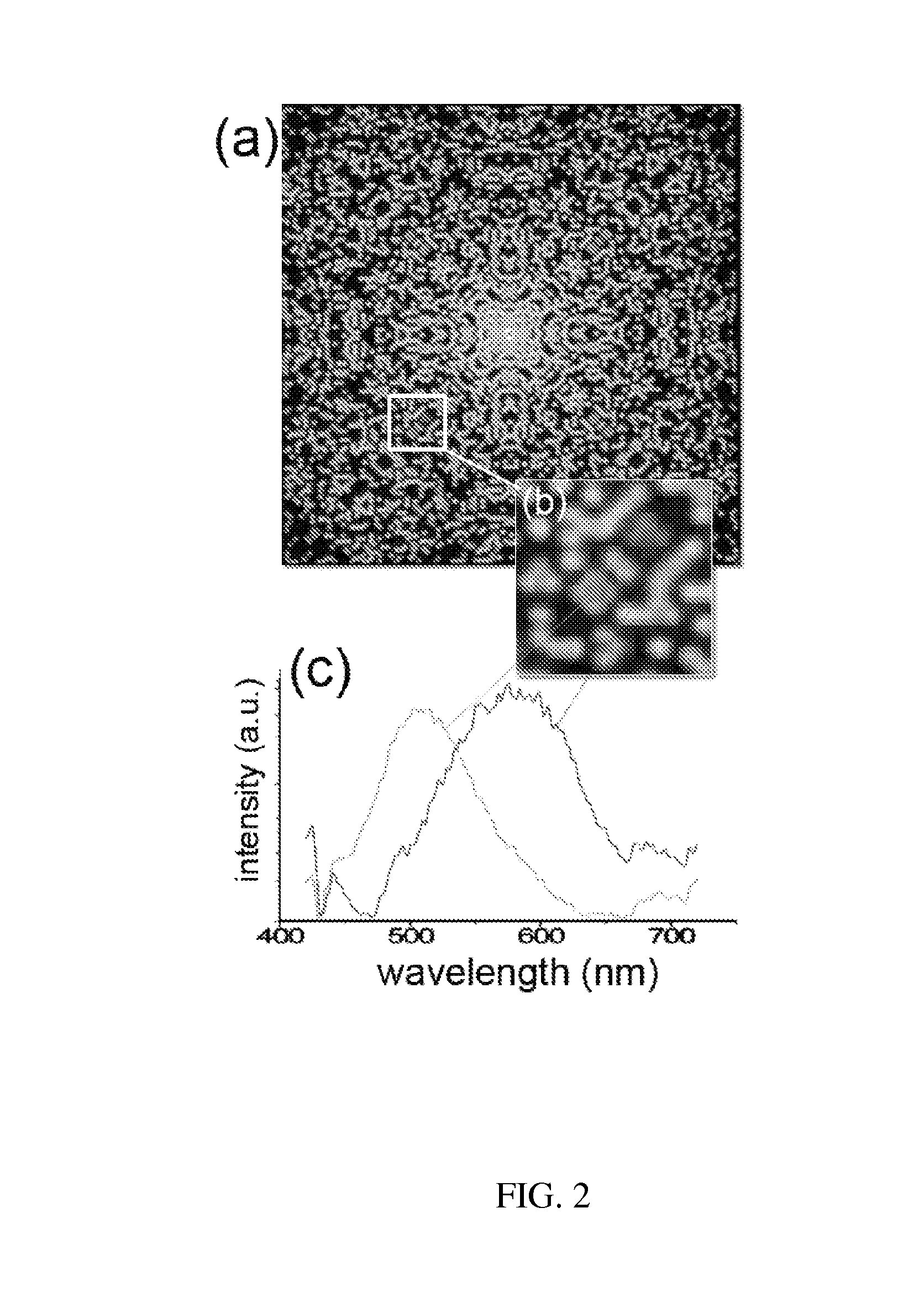Silk based biophotonic sensors
a biophotonic sensor and micro-silk technology, applied in the field of micro-silk based biophotonic sensors, can solve the problems of inability of light waves to interact with adsorbed or chemically bound analytes present on the surface of these sensors, intrinsic limitations, and the inability of light waves to provide frequency selective responses useful for colorimetric detection
- Summary
- Abstract
- Description
- Claims
- Application Information
AI Technical Summary
Benefits of technology
Problems solved by technology
Method used
Image
Examples
example 1
Gratings Fabrication
[0145]Periodic and aperiodic nanoparticle arrays were fabricated using Electron Beam Lithography (EBL) on quartz substrates. The fabrication process flow is as follows: A 180 nm of PMMA 950 (Poly Methyl Meth Acrylate) was spin-coated on top of quartz substrates, and the substrates were soft-baked on a hot plate at 180° C. for 90 sec. A 10 nm-thin continuous gold film was then sputtered on top of the resist to facilitate electron conduction for EBL writing. The nanopatterns were defined using a Zeiss SUPRA™ 40 VP SEM (Zeiss, Oberkochen, Germany) equipped with Raith beam blanker (Raith, Dortmund, Germany) and Nanometer Pattern Generation System (NPGS) for nanopatterning. The resist was subsequently developed and a 40 nm Cr thin film was deposited by e-beam evaporation. After lifting-off using acetone solution, the arrays with Cr nanoparticles were obtained. The resulting features of nanopatterned arrays are shown in FIG. 9 and are approximately 40 nm in height with...
example 2
Preparation of Silk Material
[0146]Production of silk fibroin solutions has been described previously. Perry et al., 2008; McCarthy et al., 54 J. Biomed. Mats. Res. 139 (2001). Briefly, sericin, a water-soluble glycoprotein bound to raw fibroin filaments, was removed from the silk strands by boiling B. mori cocoons in a 0.02 M aqueous solution of Na2CO3 for 30-60 min. Thereafter, the remaining silk fibroin bundle was rinsed thoroughly in purified water to extract the glue-like sericin proteins and allowed to dry overnight. The dry fibroin bundle was then dissolved in a 9.3 M aqueous solution of LiBr at room temperature or heated at 60° C., yielding a 20 wt % solution. The LiBr salt was then extracted from the solution over the course of 48 hrs or more, through a water-based dialysis process using Slide-A-Lyzer® 3.5K MWCO dialysis cassettes (Pierce, Rockford, Ill.). Any remaining particulates were removed through centrifugation and syringe-based micro-filtration (5 μm pore size, Milli...
example 3
Dark-Field Scattering Setup and Image Acquisition
[0150]FIGS. 4B-4D and FIG. 5F were collected in dark-field under white light illumination using a backscattering microscope setup with a 50× objective (N.A.=0.5) and a CCD digital camera (Media Cybernetics Evolution VF). The incident angle of the illumination was approximately 15° to the array plane, as shown in the FIG. 4E. Dark-field images and wavelength spectra were also measured in a transmission configuration using a dark-field condenser with N.A. 0.8-0.92. The transmitted light was collected with a 10× objective through a 1 mm iris (decreasing the N.A. ˜0.1) and spectral images were obtained using a hyperspectreal CCD (CRi Nuance FX) camera coupled to an Olympus IX71 microscope (FIG. 6, FIG. 7, FIG. 8).
PUM
| Property | Measurement | Unit |
|---|---|---|
| height | aaaaa | aaaaa |
| radius | aaaaa | aaaaa |
| distance | aaaaa | aaaaa |
Abstract
Description
Claims
Application Information
 Login to View More
Login to View More - R&D
- Intellectual Property
- Life Sciences
- Materials
- Tech Scout
- Unparalleled Data Quality
- Higher Quality Content
- 60% Fewer Hallucinations
Browse by: Latest US Patents, China's latest patents, Technical Efficacy Thesaurus, Application Domain, Technology Topic, Popular Technical Reports.
© 2025 PatSnap. All rights reserved.Legal|Privacy policy|Modern Slavery Act Transparency Statement|Sitemap|About US| Contact US: help@patsnap.com



